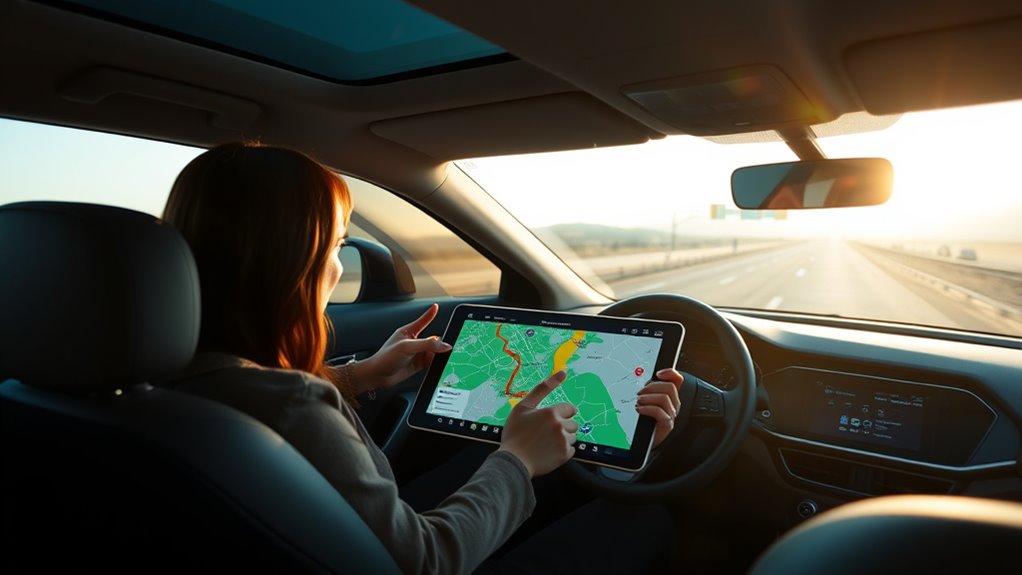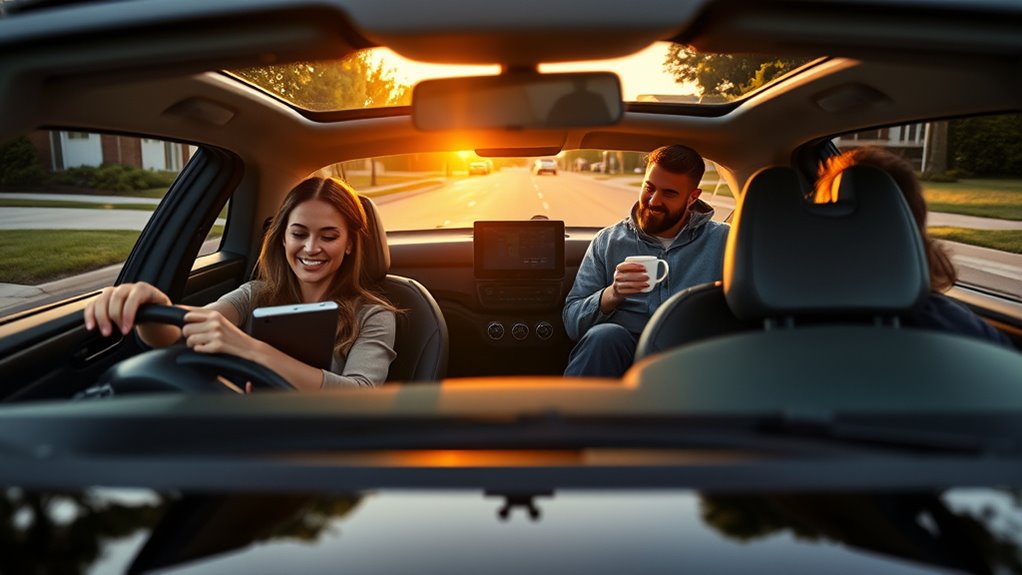To save time on driving shifts, coordinate schedules carefully with your partner by using shared calendars and planning ahead. Carpool efficiently by assigning roles based on strengths, and switch driving duties regularly to prevent fatigue. Optimize your routes with real-time traffic updates and group errands by location to reduce backtracking. Flexible work or school schedules can help avoid rush hours. Keep refining your routine, and discover more ways to streamline your driving for maximum time savings.
Key Takeaways
- Establish consistent, mutually agreed driving schedules to reduce decision fatigue and streamline routines.
- Use shared calendars or apps to coordinate and visualize shift timings clearly.
- Assign roles based on strengths, alternating driving and relaxing duties to prevent fatigue.
- Optimize routes by grouping errands and avoiding peak hours with real-time traffic updates.
- Incorporate flexibility by adjusting schedules for traffic patterns, work hours, and external factors to save time.
Coordinating Schedules to Minimize Overlaps

To effectively minimize overlaps in your driving schedules, you need to communicate openly and plan ahead. Sit down together and review each other’s work commitments and personal plans. By understanding your partner’s busiest times, you can identify windows when one of you is free to drive. Use shared calendars or scheduling apps to mark your shifts clearly. Flexibility is key—be willing to adjust your schedules if conflicts arise. Set specific times for each person’s driving duties, avoiding last-minute overlaps. Consistently update your plans as new commitments come up. Clear communication and proactive planning guarantee you avoid double-booking, reduce stress, and make your driving shifts more efficient. Additionally, being aware of schedule overlaps can help you proactively address potential conflicts before they happen. This approach helps you work as a team, saving both time and energy.
Carpooling Strategies for Efficiency

Once you’ve coordinated your individual driving schedules, carpooling becomes a powerful way to boost efficiency. To maximize benefits, assign roles based on each person’s strengths and preferences. For example, one of you might handle the driving while the other relaxes or handles quick tasks. Keep your carpool consistent, so it becomes routine and reduces decision fatigue. Use shared technology, like apps or calendars, to remind you of pickup times and locations. Establish clear communication about any schedule changes or delays. Consider combining errands or stops along your route to save additional time. By sticking to a shared plan, you minimize disruptions and streamline your mornings. Incorporating efficient route planning can further optimize your trips. Effective carpooling reduces stress, cuts costs, and ensures you both arrive on time with less effort. Additionally, understanding wealth management strategies can help you make informed decisions about your financial future. Implementing a maintenance schedule for your vehicle can also prevent unexpected breakdowns and keep your car running smoothly.
Planning and Optimizing Daily Routes

Start by mapping out your weekly tasks to see what needs to be done and when. Prioritize essential errands to save time and avoid unnecessary backtracking. Use real-time traffic updates to adjust your routes on the go for a smoother journey. Incorporating dynamic contrast ratios into your planning can help identify potential delays and optimize your routes further. Additionally, considering effective exfoliation techniques can contribute to healthier skin, making your overall routine more efficient. To bolster your planning, integrating fraud detection techniques can help ensure your route adjustments are secure and reliable, especially when using digital tools.
Map Out Weekly Tasks
Have you ever wondered how couples can streamline their weekly routines to save time and reduce stress? The key is mapping out your tasks ahead of time. Sit down together and list all errands, appointments, and chores for the week. Group similar tasks by location and time, then create a rough schedule that minimizes backtracking. Use a shared calendar or planning app to visualize your week, making adjustments as needed. Planning your routes in advance helps you identify overlapping errands and allocate driving shifts efficiently. This way, you avoid wasted trips and last-minute scrambles. When you map out your weekly tasks, you gain clarity and control, utilizing online tools to enhance your planning efficiency. Proper planning guarantees smoother days and more quality moments together. Additionally, considering the expiration dates of your errands or supplies ensures everything runs smoothly without unexpected setbacks. Being aware of survivalism principles, such as resource management and preparedness, can further optimize your routines for unforeseen circumstances.
Prioritize Essential Errands
Building on your weekly planning, focusing on your most important errands can make a big difference in how smoothly your days flow. Prioritizing essential tasks helps you avoid unnecessary trips and saves time. Start by identifying must-do errands, like grocery shopping or pharmacy runs, and schedule them early in the day. Combine nearby tasks to minimize backtracking. Consider the time of day—avoid peak hours for busy errands. Keep a list of priority errands so you don’t forget vital stops. Reassess regularly to adjust for changing needs. Staying aware of fatherhood principles can motivate you to manage your time more effectively, making your errands more beneficial for your health. This approach keeps your routes efficient and reduces stress. Additionally, understanding the industry trends can help you adapt your planning strategies more effectively, making your errands more beneficial for your health.
Use Real-Time Traffic Data
Using real-time traffic data allows you to adjust your routes on the fly, helping you avoid delays and stay on schedule. By monitoring live updates from navigation apps or GPS devices, you can identify congestion, accidents, or road closures ahead of time. When you notice an issue, rerouting becomes straightforward, saving you time and reducing stress. This proactive approach guarantees you’re not stuck in traffic longer than necessary, especially during peak hours. Incorporating real-time data into your planning means you can make informed decisions quickly, optimizing your route based on current conditions. Staying flexible with your routes keeps your driving efficient and helps you maintain a smooth schedule. Additionally, understanding Bank SWIFT/BIC codes can be useful if you need to make international transactions related to your travel or car services. Recognizing the importance of traffic pattern analysis can further enhance your ability to anticipate delays and plan accordingly. Moreover, leveraging predictive analytics can provide insights into future traffic trends, further refining your route planning. Being aware of family-related personal background details can also help you plan routes that avoid areas with high traffic during family visits or events.
Utilizing Technology for Real-Time Traffic Updates

Using technology for real-time traffic updates keeps you ahead of delays and surprises. Live traffic alerts and navigation apps provide instant updates, helping you choose the fastest route. By adjusting your plans on the fly, you and your partner can save time and reduce stress during your drives. Incorporating performance cookies can also help optimize your navigation experience based on traffic patterns. Additionally, leveraging calming decor elements in your car environment can promote relaxation and reduce stress during commutes. Implementing vehicle tuning strategies like ECU remapping and suspension upgrades can further enhance driving efficiency and comfort. Being aware of currency fluctuations can also help you plan better if you’re traveling internationally during your commute or trips.
Live Traffic Data Alerts
Real-time traffic data alerts have become essential tools for couples coordinating their driving shifts, as they provide instant updates on road conditions and delays. With these alerts, you can avoid unexpected traffic jams, accidents, or construction zones that might slow you down. They help you make quick decisions about when to leave or which route to take. These alerts often come through your smartphone or in-car system, offering timely information right when you need it most. For example, knowing last-minute route changes can help you adapt quickly to evolving traffic situations. The integration of live traffic updates into navigation apps has significantly improved the efficiency of planning driving shifts. Regular use of traffic monitoring tools can also help anticipate congestion patterns and optimize your route choices. Recognizing patterns in angel number signals can further enhance your understanding of the best times to travel.
Navigation App Integration
Navigation app integration enhances how couples coordinate their drives by providing seamless, real-time traffic updates directly through their devices. With this technology, you can see current traffic conditions, accidents, and road closures instantly, helping you choose the fastest route. Many apps allow you to share your ETA and route details with your partner, ensuring you’re both informed and aligned. This reduces the need for constant phone calls or questions about delays. You can also set preferences for avoiding tolls or highways, streamlining your journey. Using integrated navigation tools keeps you updated without distraction, allowing you to focus on driving safely. Additionally, integrating smart technology can provide quick entertainment during stops or delays, making your overall driving experience more enjoyable. Real-time traffic updates rely on accurate data sources, which improve route planning and reduce unexpected delays. Overall, this technology simplifies route planning, saves time, and enhances coordination, making your shared driving experience more efficient and less stressful.
Real-Time Route Adjustments
When unexpected traffic delays occur, technology allows you and your partner to adjust your route instantly, avoiding long waits and frustration. With real-time traffic updates, you can see congestion ahead and choose alternative paths without stopping to check maps manually. This quick adjustment saves time and keeps you moving smoothly. Use apps that analyze live data to suggest ideal routes, rerouting you around accidents or roadwork. Staying flexible with your route reduces stress and keeps your schedule on track. Keep your navigation app updated and enable notifications for traffic alerts. Having this technology at your fingertips means you can respond instantly to changing conditions, making your drive more efficient and less stressful.
- Monitor live traffic conditions continuously
- Receive instant route change suggestions
- Avoid known congestion spots proactively
- Save time by bypassing delays
Sharing Driving Responsibilities Fairly

Sharing driving responsibilities fairly is essential for maintaining balance and reducing stress on both partners. You should discuss and agree on a schedule that suits both your routines and preferences. Consider factors like work hours, energy levels, and driving skills. Alternating shifts can help prevent fatigue and resentment, ensuring neither of you feels overwhelmed. Be transparent about your comfort levels and listen to your partner’s input. Flexibility is key—life can be unpredictable, so adjust your plans as needed. Clear communication prevents misunderstandings and helps both of you feel valued and supported. When you share driving duties equitably, it fosters cooperation and keeps your daily routines smooth, making the driving experience less stressful and more manageable for both of you.
Incorporating Flexible Work and School Arrangements

Have you considered how flexible work and school arrangements can ease your driving responsibilities? By adjusting your schedules, you can reduce peak-hour traffic and share driving duties more evenly. For example, you might coordinate work hours so one person starts early and leaves early, while the other begins later. You could also explore options like remote work or hybrid models to cut down on daily commutes. Additionally, shifting school start times or arranging staggered pick-up times helps avoid congestion and spreads out travel needs. These adjustments give you more control over your schedules, making it easier to plan driving shifts. Flexibility not only saves time but also reduces stress, helping you and your partner manage your busy lives more smoothly.
Frequently Asked Questions
How Can Couples Handle Last-Minute Schedule Changes Effectively?
When last-minute schedule changes pop up, you can handle them effectively by staying flexible and communicating clearly. Quickly assess your priorities, and adjust your plans or driving shifts accordingly. Keep a shared calendar or app updated so both of you stay informed. Being proactive and understanding each other’s needs helps reduce stress. Remember, staying calm and adaptable guarantees you manage unexpected changes smoothly and maintain your relationship harmony.
What Are the Best Apps for Coordinating Driving Shifts?
You want to coordinate driving shifts efficiently, so using the right apps can make a big difference. Apps like Google Calendar help you schedule and share shifts easily, while Cozi keeps everyone on the same page with shared to-do lists. Doodle is great for quick scheduling, and When I Work simplifies shift management. These tools streamline communication, reduce conflicts, and save you time when managing your driving responsibilities.
How Do Weather Conditions Impact Route Planning Strategies?
Weather conditions considerably impact your route planning strategies. You need to stay informed about forecasts to avoid heavy rain, snow, or storms that can cause delays or hazardous driving conditions. Adjust your routes by choosing major roads less affected by weather or consider leaving earlier or later to dodge bad weather. Always check real-time traffic updates and plan backups to guarantee a safer, smoother trip, saving time and reducing stress.
What Safety Measures Should Be Prioritized During Shared Driving?
Imagine you’re steering a delicate dance on the road. Safety measures like wearing seat belts are your steady rhythm, ensuring you’re secure in every step. Keep distractions at bay, like silent partners, so your focus stays sharp. Regular vehicle checks are your safety net, catching issues before they become a fall. Prioritize alertness, communicate clearly, and stay attentive to your partner’s cues—your shared journey depends on mutual care.
How Can Couples Balance Driving Responsibilities With Personal Time?
Balancing driving responsibilities with personal time means you need to communicate openly with your partner. Set clear schedules so both of you get quality moments apart and together. Switch driving duties regularly to prevent fatigue, and plan breaks for personal activities. By sharing tasks fairly, you ensure neither of you feels overwhelmed, allowing you to enjoy your time off while maintaining safe, efficient driving routines.
Conclusion
By coordinating your schedules, carpooling smartly, and using real-time traffic updates, you can turn your busy routines into a well-oiled machine. Sharing driving duties fairly keeps stress levels low and energy high, while flexible work and school plans add an extra layer of ease. Think of these tips as the gears in a well-tuned engine—each working together to make your daily drive smoother and more efficient, so you can enjoy more time together and less time stuck in traffic.









